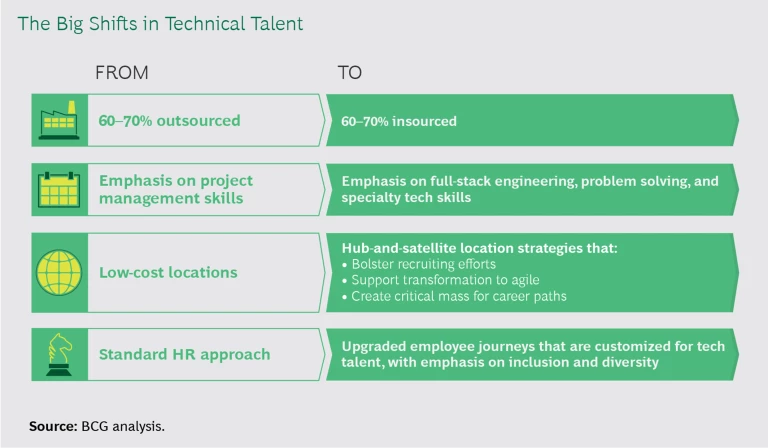The CEO of a global financial services company was frustrated. The company’s digital transformation was stalled on several fronts, delaying the rollout of new products and the implementation of new processes—it was costing millions. While there were multiple problems, they all had one root cause: the company did not have the technical talent it needed, and it could not seem to get it.
The CEO called a meeting and instructed her direct reports to check their agendas at the door. This was no time for the COO and heads of finance, HR, and IT to get bogged down in turf-based proposals or hashing out issues specific to one silo or another. The problem was company-wide.
As the discussion progressed, the underlying issue became clear: the company had not updated its strategy for recruiting, developing, or managing talent —particularly technical talent—since the mid-1980s. The company was outsourcing two-thirds of its technical staff to low-cost and usually offshore locations. IT was seen as a cost center, its budget scrutinized with a keen eye for cost control every year.
While the company had been working to scale up agile ways of working in IT and other functions, its recruiting efforts emphasized project management over cross-functional, collaborative skills. The company had yet to develop career path trajectories (for both technical or business talent) that reflected its shift to agile at scale.
It was a wonder, the CEO thought as the meeting came to a close, that the company was able to recruit anybody.
Changing Times, New Priorities
The story is fictional, but it is also true—the elements all come from recent client cases. So how did we get here? It wasn’t for lack of strategy or because CIOs and their teams didn’t do the right things. The model used in the 1980s and 1990s was a good one for that time, business environment, and needs. For many, it meant outsourcing IT, and making it lean. The goal was functional excellence in IT combined with minimized costs, automated processes, and a clear mandate to support such things as end-user computing, data center management, infrastructure, and help desks.
The IT staffing model used in the 1980s and 1990s was a good one for that time, business environment, and needs.
That era of back-office, outsourced IT has run its course. Companies today need a people strategy for their tech functions that reflects tech’s front-and-center position in product design, customer engagement, and redesigning business processes. Since tech talent is competitive, scarce, and tough to attract, companies that get it right first can establish an enduring advantage. Those that stick to the old ways of doing things will find catching up difficult.
The IT Remit Redefined
Digital tools and ways of working drive many of the demands of business today, making technology integral to other key functions, including marketing and sales; innovation, product development, and R&D; supply chain management; and manufacturing and service delivery. Compounding that, the need to employ agile ways of working imposes an imperative to operate cross-functionally.
As with any long-running strategy, the traditional approach to tech talent has established several legacy ways of doing things that are now barriers to progress. Four of these in particular impede companies’ ability to attract and retain top talent:
- An overreliance on contractors
- A lack of necessary in-house skill sets
- Dated and disparate strategies for locating employees
- Outdated talent acquisition and development processes
Cutting-edge IT leaders are revamping the vision for tech talent in their organizations.
Cutting-edge IT leaders—enthusiastically supported by their CEOs—are revamping the vision for tech talent in their organizations. (See the exhibit.) They are boldly putting in place a new model with forward-thinking talent strategies that directly address these four important challenges.
Revisit the outsourcing ratio. Here’s a test for IT leaders: When you walk the halls of your workplace, do you catch snippets of conversations about technology, product, and code? Or do you hear conversations about project management, timelines, and outsourced provider management? It’s more than likely you’re hearing the latter, which means that the conversations related to your intellectual property (IP) are happening at your outsourced provider. This also means that the keys to your kingdom are held by hands outside your company. Those providers have your IP and data, and they have no incentive to innovate with either.
Heavy outsourcing means the keys to your kingdom—intellectual property and data—are held outside your company, limiting your ability to innovate.
At most big companies, somewhere between 60% and 70% of technology functions are outsourced. At some, it’s as high as 85% to 90%. But leading-edge technology organizations are moving fast to reverse the contractor-employee ratio and bring 60% to 70% of their talent needs in-house. Virtually every tech function we’ve worked with on people strategies in recent years has revisited the mix, with most shifting toward a two-thirds to one-third weighting of in-house to outsourced talent. Some shifts have been so bold that the companies have three-to-five-year recruiting targets numbering thousands of people. The cost of such a change can appear to be a big barrier, but read on to see how you can achieve this rebalancing with near-zero impact on your budget.
Expand the range of in-house skills. The talent sourcing model is one issue. The short half-life of technology skills is another. IT teams today often lack the necessary talent to execute their strategies. They are often made up of project and program managers, integrators, and legacy language coders—roles that are still important today but incomplete. When the absence of the necessary tech acumen becomes apparent (whether it involves data science, software engineering, artificial intelligence, or some combination of advanced skills), IT teams source the required skills from contract providers, compounding the problems that go along with putting intellectual property in nonemployees’ hands.
More and more IT leaders are now recruiting full-stack engineers, experts on artificial intelligence and machine learning, and people with cloud, agile, and modern coding language skills, in addition to problem-solving ability.
Leading CIOs, with the earnest support of chief human resources officers, are using a full complement of talent-sourcing strategies to fill identified gaps, such as refreshing talent acquisition strategies, upskilling and reskilling current staff, and establishing internship and work-training programs. Many find that they need to redesign job architectures and career paths to effectively market for these roles, by making the work and development opportunities attractive.
Locate people where they can work most effectively. Chances are, the location decisions you made for your IT function, while making good sense years ago, now hinder your options in critical ways. One is the ability to attract new talent. Another is putting together and collocating cross-functional agile teams, which is tough to do when the tech folks are not in the same place as your business experts.
A hub-and-satellite location approach is emerging as a favored strategy among early-moving tech organizations. These companies locate most of their tech teams in central locations, usually near or with business units in cities that attract tech talent. They have three goals in mind: bolstering their recruiting efforts, supporting transformation to agile methods with faster iteration cycles, and creating critical mass for career path and culture-building purposes. These companies also establish satellite locations for access to particular tech talent pools or business-specific collocation. Most also allow for limited numbers of fully virtual workers.
Adapt HR support to today’s talent needs. HR typically supports the IT function with an HR business partner, a role that exists across all businesses and functions. Few companies have recognized the need to adapt this model for today’s IT function. Yet IT cannot wait for the rest of the company to catch up. It can’t recruit, develop, and train digital talent with “analog” HR support. The typical support model that follows company-wide talent acquisition, onboarding, interning, mobility, and employee development processes won’t keep up with what modern tech talent is accustomed to.
Modern tech talent is looking for a different experience—a journey they can talk about with peers, who could well be working at Google, Amazon, or a tech-based startup. The speed at which HR can crank someone through the process is important, but what matters more is the way candidates and new employees experience a company’s culture and its employee value proposition. And the first place they do this is during the talent acquisition processes.
Today’s talent expects a job application that takes 60 seconds to complete, and which automatically links to their professional social media account. They want a virtual interview, a gamified assessment that tests their tech chops, and a dialogue with a tech leader who makes waves and works on interesting projects. They look for clear insights into a company’s inclusion policies and diversity impact, with a call back within hours—not days or weeks. They want an intern experience that makes them the envy of their college campus when they return for their final year.
The HR-IT partnership has become one of the most important in the enterprise. Companies today need to continuously build a pipeline of talent, not wait for a new requisition to be approved before filling the interview slate. At leading companies today, the IT and HR teams join forces to tackle this employee journey redesign, incubate new approaches, and share the lessons learned with enterprise HR.
The HR-IT partnership has become one of the most important in the enterprise; companies today need to continuously build a pipeline of talent.
Getting Into the Game
Revamping your people strategy requires vision and intent. As in the case of our fictional financial-services CEO, leadership needs to get involved and articulate the case for transforming the back-office IT function into the leading tech organization of the future. Making the shift requires an HR team that is as visionary as the CIO. Implementing a new people strategy for IT often means revisiting the role of frontline leaders throughout the organization, reskilling or upskilling current employees, taking new approaches to undergraduate hiring and onboarding, and rethinking inclusion and diversity efforts.
In our experience, successful companies rely heavily on agile teams to implement their talent transformations, which also helps them attract a new generation of employees. Many undertake talent transformation as part of a larger revamping of their technology or platform strategy, a redesign of their operating model or organization, or a post-merger integration program.
Whatever the catalyst, the time to revisit your people strategy is now, before adopting a tech talent approach that can work in the 2020s becomes a missed opportunity.











